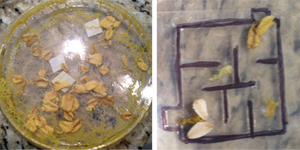Slimy, but Smart: Slime Mold Science
Can an organism without a brain solve complex problems? A school science project puts slime mold to the test.
"Slime mold? Really?!?" I was not thrilled when my son announced the topic he had chosen for his science project. Slime molds are blob-like masses that move at a snail's pace, eating any decaying organic material in their path. I thought it sounded like something I'd rather avoid than bring into my house.

Meet Physarum polycephalum
After vetting various ideas, my son settled on an experiment based on the Smarter Than Your Average Slime: Maze-solving by an Amoeboid Organism project from Science Buddies. This project involves culturing Physarum polycephalum, a type of slime mold that exhibits primitive intelligence, and then seeing if it can find the shortest route between two food sources placed in a maze. Intrigued by the idea that an organism without a brain could solve problems, I started warming to the idea of having slime mold in the house.
A Bumpy Start
When the slime mold culture kit arrived in the mail, it didn't contain an oozing blob, but a dry, dormant version of Physarum polycephalum called sclerotium. There were also several empty petri dishes and bottles of jello-like agar, which is used as a growing medium. The idea was to heat the agar so it melted to a liquid state, pour it into the petri dishes, and then transfer the sclerotium so it would begin to grow.
Per his science teacher's requirements, my son was only basing his experiment on the Science Buddies Project Idea, and not following the Science Buddies procedure step-by-step. So, to prepare his petri dishes, my son boiled water, turned off the heat, set the bottle of agar in the pot, and waited for it to melt. Nothing happened. He re-boiled the water and tried again. Still no melting.
A YouTube video from Carolina Biological showed him the correct way to melt the agar, and thirty minutes later, it was cooling in the petri dishes. When it reached room temperature, my son transferred the dormant sclerotium to the petri dishes and added some oatmeal flakes for them to eat. Now he had to wait again, this time for the Physarum polycephalum to convert itself to its active plasmodial state.
It's Alive!
Over the next couple of days, the Physarum polycephalum began to fill the petri dishes with its bright yellow-orange webs. Far from disgusted, I was fascinated. I named it "Slim," and would ask my son, "How's Slim doing today?"
Meanwhile, my son created another set of agar-filled petri dishes, adding small mazes that he had drawn with crayon onto coffee filter paper. His prediction was that the slime mold wouldn't want to grow over the waxy crayon lines. When the Physarum polycephalum was ready for transfer, he carefully cut it into pieces, and added it to the mazes. With oatmeal flakes at both ends of the maze, we wondered, would it really find the shortest path? Or would it just fill the whole dish? I couldn't wait to find out!
Two Steps Forward, One Step Back
Physarum polycephalum prefers to avoid sunlight, so my son stored it in a cabinet, but I always looked over his shoulder when he checked on its progress. Unfortunately, after a couple of days, it seemed clear that Slim didn't mind growing over the crayon "walls" of the maze. It was filling the whole petri dish and devouring the oat flakes with abandon. Evidently the crayon wasn't thick enough.
With time running short, my son didn't want to risk another failed crayon maze experiment, so he switched to mazes made out of acetate—the thin plastic sheets used on overhead projectors. He drew the mazes with black permanent marker and then painstakingly cut them out with a utility knife. After creating new petri dishes, my son added the mazes, pieces of Physarum polycephalum, and fresh food. Time to wait again!
The Final Leg of a Slow-Motion Race
By the next morning, the Physarum polycephalum had started to grow through the mazes. My son downloaded a time-elapse camera app, and set it up to film its progress while he was at school. Slim continued to grow all day, and through the night as well.
In the end, it turns out that slime mold is pretty smart. When navigating many of the mazes, it found the shortest path between the two food sources. Not bad for no brain! I'm definitely a fan.
Categories:
You Might Also Enjoy These Related Posts:
- Plastics and Earth Day - Science Projects
- Arduino Science Projects and Physical Computing
- 10+ Robotics Projects with the BlueBot Kit
- 5 STEM Activities with Marshmallow Peeps
- March Madness Basketball Science Projects: Sports Science Experiments
- Women in STEM! More than 60 Scientists and Engineers for Women's History Month
- Explore Artificial Intelligence and Machine Learning with Student AI Projects
- 10 Reasons to Do the Rubber Band Car Engineering Challenge










